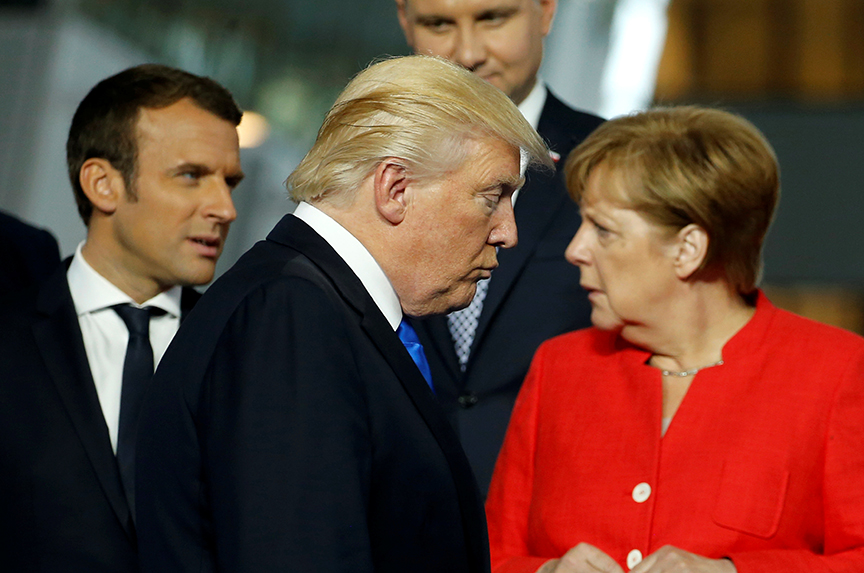These three dangers have never come together simultaneously: openly expressed US presidential doubts over the cost and value of transatlantic commitments; growing, migrant-driven populist dangers tearing at European unity; and rising trade conflicts without any offsetting common project to repair fraying bonds.
First, the US president is more openly questioning the key institutions—particularly NATO and the European Union—that have been the glue that has held together what has been known as “the Free World” for the seven decades since World War II. Said Trump, “the European Union, of course, was set up to take advantage of the United States.”
Second, migrant controversies are driving populist politics that are pulling at the seams of the European Union. An EU deal hashed out just before the weekend to better share the migrant burden seems to have done less to solve differences than to underscore the stubborn nature of the nationalist and populist challenge, most perilously from Italy.
Finally, North America and Europe lack any new and galvanizing economic or security project to recharge transatlantic relations. Instead, new US tariffs and EU countermeasures are deepening the divide after the acrimonious G7 talks and US withdrawals from the Paris climate agreement and the Iran nuclear deal. President Trump’s visit to Europe this month for a NATO summit, to be followed by a Helsinki meeting with Russia’s Vladimir Putin, could help repair the rift – or further widen it.
All that left Poland’s Donald Tusk, the President of the European Council, telling EU leaders late this week that Trump poses a serious threat to Western unity that should not be dismissed. “He has a method and is serious in his mission against an international rules-based order,” Tusk told his fellow EU leaders. “He is on a mission against what we stand for.”
US Secretary of State Mike Pompeo disagrees. Reacting to the rising chorus of European concern, he told the Wall Street Journal’s Walter Russell Mead in an interview that the Trump purpose isn’t to wreck the global system but rather align it with new realities.
It’s worth reading Pompeo closely, as a new transatlantic bargain presents itself that is based on a pragmatic, interest-based approach freed of the nostalgia of what global institutions and alliances have provided the US and its allies in the past. Trump doesn’t believe that structure pays the US dividends now, so he is focused instead on how it will enhance US power going forward into a new era of major power competition.
It’s easy to get so lost in President Trump’s inflammatory rhetoric that one assumes his purpose is destruction, not reform, but that’s not Pompeo’s view. “When I watch President Trump give guidance to our team, his question is always, ‘How does that structure impact America in 2018 and beyond.’” Trump’s “prepared to be disruptive,” Pompeo says, “when he sees arrangements that put America, and American workers, at a disadvantage.”
Mead writes that Trump’s agenda, as communicated by Pompeo, “is one of extraordinary ambition: to rewrite the rules of world order in America’s favor while working out stable relationships with geopolitical rivals.” Pompeo sees his task as reforming rules “that no longer are fair and equitable” while maintaining “the important historical relationships with Europe and the countries in Asia that are truly our partners.”
If Trump’s approach is indeed more to reform than destroy, this would be a good month to begin to demonstrate that at NATO and with Putin. At NATO, he could take a victory lap to celebrate the alliance’s positive trajectory during his watch in creating new commands, increasing defense spending, sharpening military readiness and deepening support for anti-terrorist operations in Iraq and elsewhere. With Putin, he could make crystal clear that sanctions won’t budge until he’s out of Ukraine – and underscore his commitment to NATO allies on the front lines.
Or he could tee up the summit with new tariffs on German cars, take new swipes at allies for falling short of defense spending commitments, and send a less than clear message to Putin regarding his commitment to NATO allies on the front lines.
The nightmare scenario for European allies is that he would leave the NATO summit in conflict with his partners and follow it with a common cause meeting with Putin.
What Pompeo told Mead is that, to be able to speak with confidence for the President around the world, he spends “a lot of time … trying to make sure that I have my whole workforce, my whole team, understanding the commander’s intent in a deep way.”
He’ll want to share those conclusions with his European partners this month as so much hangs on the answer. They’ll want to hope Pompeo is right that the intent is more to reform than destroy.
Frederick Kempe is president and chief executive officer of the Atlantic Council. You can follow him on Twitter @FredKempe. This blog post is based on his weekly InflectionPoints newsletter. Read the newsletter in full here.
Image: US President Donald Trump (center) walked past French President Emmanuel Macron (left) and German Chancellor Angela Merkel on his way to his spot for a family photo during the NATO summit in Brussels, Belgium, on May 25. (Reuters/Jonathan Ernst)

